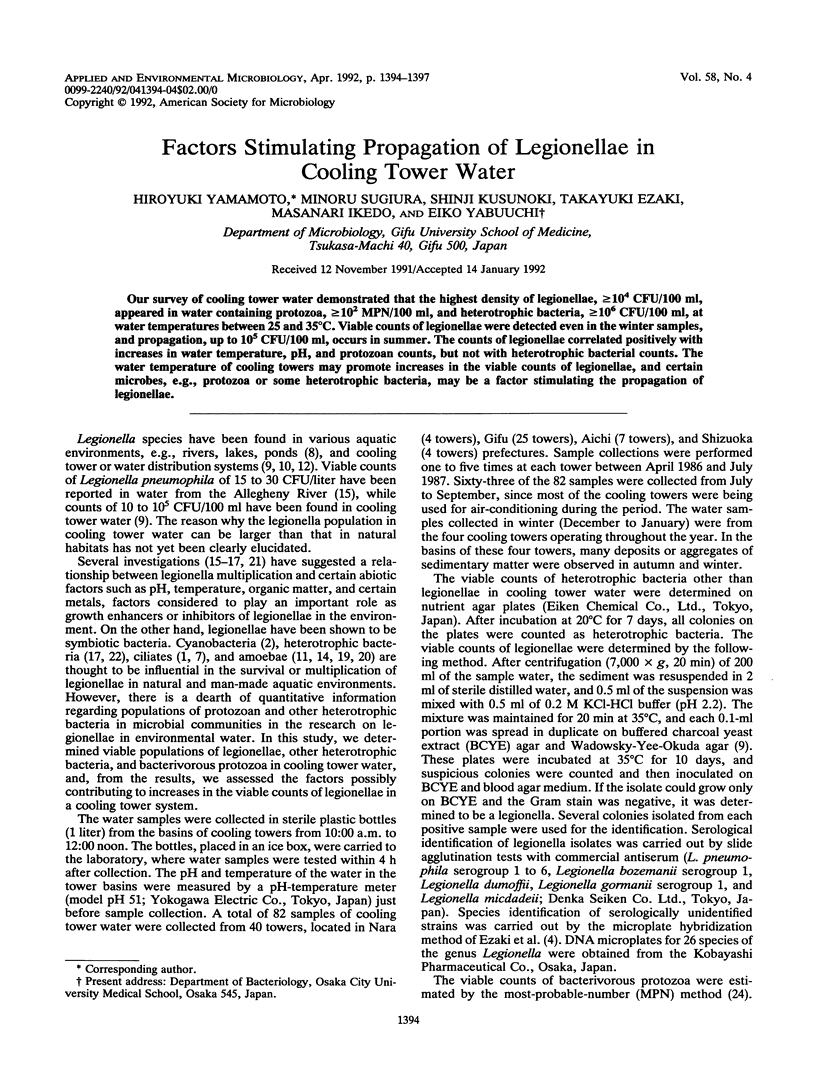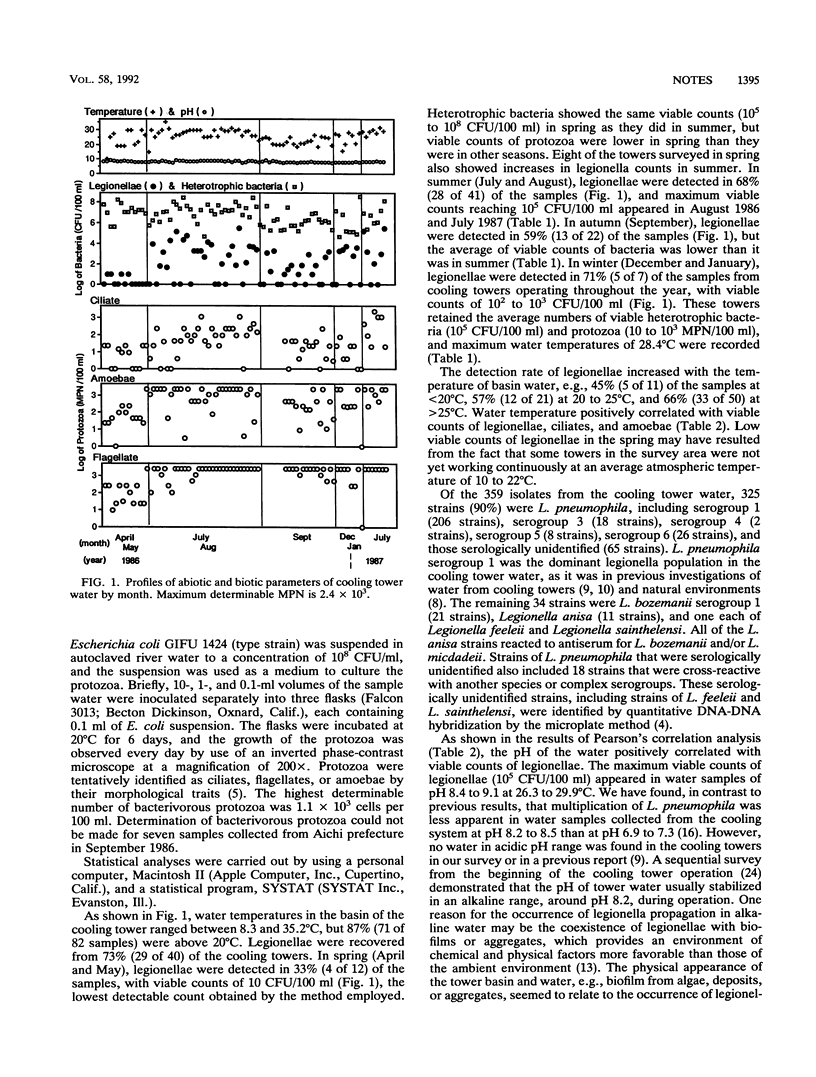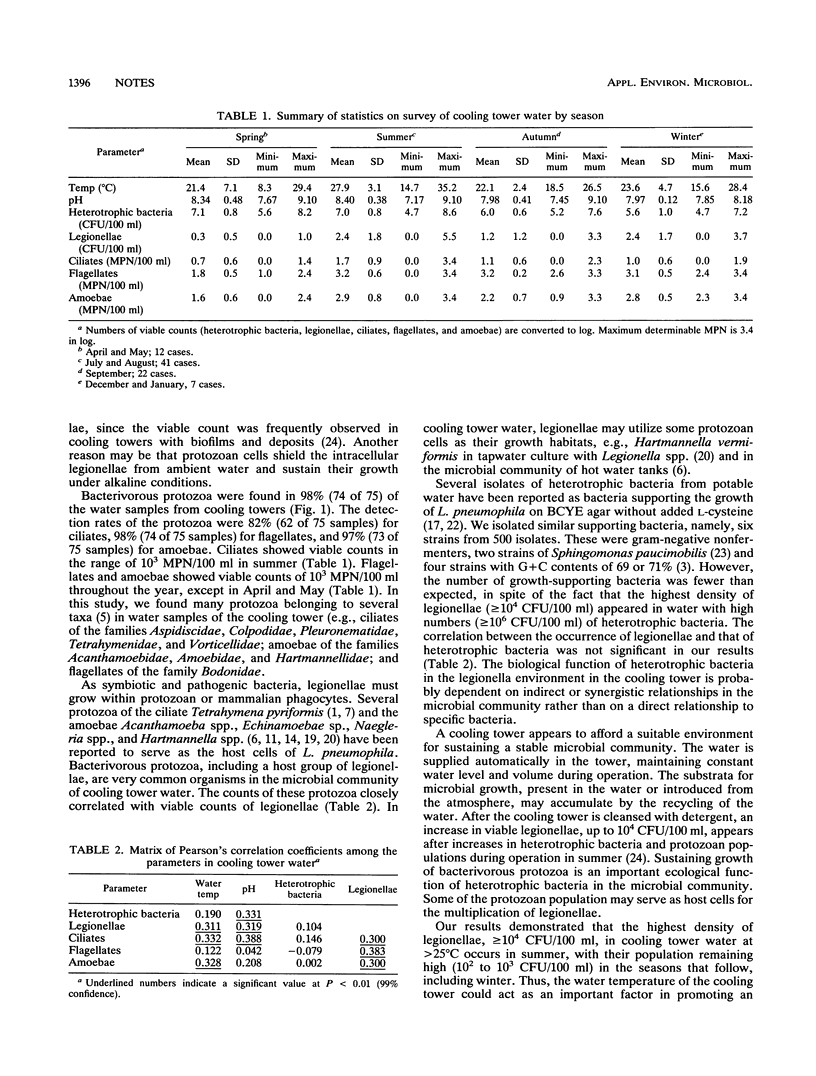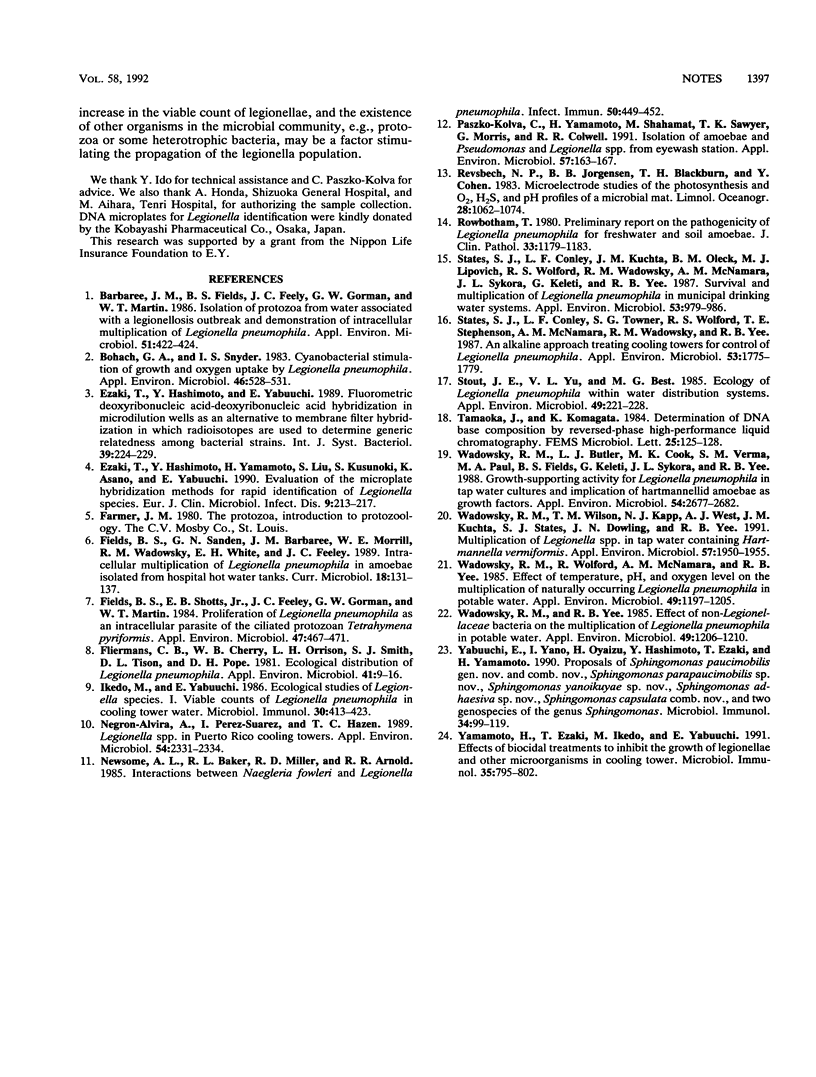Abstract
Our survey of cooling tower water demonstrated that the highest density of legionellae, ≥104 CFU/100 ml, appeared in water containing protozoa, ≥102 MPN/100 ml, and heterotrophic bacteria, ≥106 CFU/100 ml, at water temperatures between 25 and 35°C. Viable counts of legionellae were detected even in the winter samples, and propagation, up to 105 CFU/100 ml, occurs in summer. The counts of legionellae correlated positively with increases in water temperature, pH, and protozoan counts, but not with heterotrophic bacterial counts. The water temperature of cooling towers may promote increases in the viable counts of legionellae, and certain microbes, e.g., protozoa or some heterotrophic bacteria, may be a factor stimulating the propagation of legionellae.
Full text
PDF



Selected References
These references are in PubMed. This may not be the complete list of references from this article.
- Barbaree J. M., Fields B. S., Feeley J. C., Gorman G. W., Martin W. T. Isolation of protozoa from water associated with a legionellosis outbreak and demonstration of intracellular multiplication of Legionella pneumophila. Appl Environ Microbiol. 1986 Feb;51(2):422–424. doi: 10.1128/aem.51.2.422-424.1986. [DOI] [PMC free article] [PubMed] [Google Scholar]
- Bohach G. A., Snyder I. S. Cyanobacterial stimulation of growth and oxygen uptake by Legionella pneumophila. Appl Environ Microbiol. 1983 Aug;46(2):528–531. doi: 10.1128/aem.46.2.528-531.1983. [DOI] [PMC free article] [PubMed] [Google Scholar]
- Ezaki T., Hashimoto Y., Yamamoto H., Lucida M. L., Liu S. L., Kusunoki S., Asano K., Yabuuchi E. Evaluation of the microplate hybridization method for rapid identification of Legionella species. Eur J Clin Microbiol Infect Dis. 1990 Mar;9(3):213–217. doi: 10.1007/BF01963841. [DOI] [PubMed] [Google Scholar]
- Fields B. S., Shotts E. B., Jr, Feeley J. C., Gorman G. W., Martin W. T. Proliferation of Legionella pneumophila as an intracellular parasite of the ciliated protozoan Tetrahymena pyriformis. Appl Environ Microbiol. 1984 Mar;47(3):467–471. doi: 10.1128/aem.47.3.467-471.1984. [DOI] [PMC free article] [PubMed] [Google Scholar]
- Fliermans C. B., Cherry W. B., Orrison L. H., Smith S. J., Tison D. L., Pope D. H. Ecological distribution of Legionella pneumophila. Appl Environ Microbiol. 1981 Jan;41(1):9–16. doi: 10.1128/aem.41.1.9-16.1981. [DOI] [PMC free article] [PubMed] [Google Scholar]
- Ikedo M., Yabuuchi E. Ecological studies of Legionella species. I. Viable counts of Legionella pneumophila in cooling tower water. Microbiol Immunol. 1986;30(5):413–423. doi: 10.1111/j.1348-0421.1986.tb02967.x. [DOI] [PubMed] [Google Scholar]
- Negrón-Alvíra A., Pérez-Suarez I., Hazen T. C. Legionella spp. in Puerto Rico cooling towers. Appl Environ Microbiol. 1988 Oct;54(10):2331–2334. doi: 10.1128/aem.54.10.2331-2334.1988. [DOI] [PMC free article] [PubMed] [Google Scholar]
- Newsome A. L., Baker R. L., Miller R. D., Arnold R. R. Interactions between Naegleria fowleri and Legionella pneumophila. Infect Immun. 1985 Nov;50(2):449–452. doi: 10.1128/iai.50.2.449-452.1985. [DOI] [PMC free article] [PubMed] [Google Scholar]
- Paszko-Kolva C., Yamamoto H., Shahamat M., Sawyer T. K., Morris G., Colwell R. R. Isolation of amoebae and Pseudomonas and Legionella spp. from eyewash stations. Appl Environ Microbiol. 1991 Jan;57(1):163–167. doi: 10.1128/aem.57.1.163-167.1991. [DOI] [PMC free article] [PubMed] [Google Scholar]
- Rowbotham T. J. Preliminary report on the pathogenicity of Legionella pneumophila for freshwater and soil amoebae. J Clin Pathol. 1980 Dec;33(12):1179–1183. doi: 10.1136/jcp.33.12.1179. [DOI] [PMC free article] [PubMed] [Google Scholar]
- States S. J., Conley L. F., Kuchta J. M., Oleck B. M., Lipovich M. J., Wolford R. S., Wadowsky R. M., McNamara A. M., Sykora J. L., Keleti G. Survival and multiplication of Legionella pneumophila in municipal drinking water systems. Appl Environ Microbiol. 1987 May;53(5):979–986. doi: 10.1128/aem.53.5.979-986.1987. [DOI] [PMC free article] [PubMed] [Google Scholar]
- States S. J., Conley L. F., Towner S. G., Wolford R. S., Stephenson T. E., McNamara A. M., Wadowsky R. M., Yee R. B. An alkaline approach to treating cooling towers for control of Legionella pneumophila. Appl Environ Microbiol. 1987 Aug;53(8):1775–1779. doi: 10.1128/aem.53.8.1775-1779.1987. [DOI] [PMC free article] [PubMed] [Google Scholar]
- Stout J. E., Yu V. L., Best M. G. Ecology of Legionella pneumophila within water distribution systems. Appl Environ Microbiol. 1985 Jan;49(1):221–228. doi: 10.1128/aem.49.1.221-228.1985. [DOI] [PMC free article] [PubMed] [Google Scholar]
- Wadowsky R. M., Butler L. J., Cook M. K., Verma S. M., Paul M. A., Fields B. S., Keleti G., Sykora J. L., Yee R. B. Growth-supporting activity for Legionella pneumophila in tap water cultures and implication of hartmannellid amoebae as growth factors. Appl Environ Microbiol. 1988 Nov;54(11):2677–2682. doi: 10.1128/aem.54.11.2677-2682.1988. [DOI] [PMC free article] [PubMed] [Google Scholar]
- Wadowsky R. M., Wilson T. M., Kapp N. J., West A. J., Kuchta J. M., States S. J., Dowling J. N., Yee R. B. Multiplication of Legionella spp. in tap water containing Hartmannella vermiformis. Appl Environ Microbiol. 1991 Jul;57(7):1950–1955. doi: 10.1128/aem.57.7.1950-1955.1991. [DOI] [PMC free article] [PubMed] [Google Scholar]
- Wadowsky R. M., Wolford R., McNamara A. M., Yee R. B. Effect of temperature, pH, and oxygen level on the multiplication of naturally occurring Legionella pneumophila in potable water. Appl Environ Microbiol. 1985 May;49(5):1197–1205. doi: 10.1128/aem.49.5.1197-1205.1985. [DOI] [PMC free article] [PubMed] [Google Scholar]
- Wadowsky R. M., Yee R. B. Effect of non-Legionellaceae bacteria on the multiplication of Legionella pneumophila in potable water. Appl Environ Microbiol. 1985 May;49(5):1206–1210. doi: 10.1128/aem.49.5.1206-1210.1985. [DOI] [PMC free article] [PubMed] [Google Scholar]
- Yabuuchi E., Yano I., Oyaizu H., Hashimoto Y., Ezaki T., Yamamoto H. Proposals of Sphingomonas paucimobilis gen. nov. and comb. nov., Sphingomonas parapaucimobilis sp. nov., Sphingomonas yanoikuyae sp. nov., Sphingomonas adhaesiva sp. nov., Sphingomonas capsulata comb. nov., and two genospecies of the genus Sphingomonas. Microbiol Immunol. 1990;34(2):99–119. doi: 10.1111/j.1348-0421.1990.tb00996.x. [DOI] [PubMed] [Google Scholar]
- Yamamoto H., Ezaki T., Ikedo M., Yabuuchi E. Effects of biocidal treatments to inhibit the growth of legionellae and other microorganisms in cooling towers. Microbiol Immunol. 1991;35(9):795–802. doi: 10.1111/j.1348-0421.1991.tb01612.x. [DOI] [PubMed] [Google Scholar]


